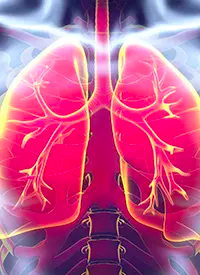Article
Neoadjuvant Nivolumab Plus Chemotherapy Bests Nivolumab Alone in Resectable NSCLC
Author(s):
Neoadjuvant treatment with nivolumab (Opdivo) plus platinum doublet chemotherapy showed superior major pathological response rates and pathological complete response rates compared with nivolumab monotherapy among patients with resectable non–small cell lung cancer even for patients with a PD-L1 expression of 50% or greater.
Non–small cell lung cancer

Neoadjuvant treatment with nivolumab (Opdivo) plus platinum doublet chemotherapy showed superior major pathological response (MPR) rates and pathological complete response (pCR) rates compared with nivolumab monotherapy among patients with resectable non–small cell lung cancer (NSCLC) even for patients with a PD-L1 expression of 50% or greater, according to data from a phase 2 study (NCT04015778).1
The findings, which were presented at the 2022 ESMO Immuno-Oncology Annual Congress, showed that the MPR rate in the overall cohort of patients (n = 46) who received either nivolumab monotherapy or nivolumab plus chemotherapy, both followed by surgery, was 56.5% (95% CI, 41.1%-71.1%) and the pCR rate was 28.2% (95% CI, 16.0%-43.5%).
Additionally, patients with a PD-L1 expression of 50% or greater who received the combination (n = 12) achieved an MPR rate of 80.0% compared with 18.2% for patients with a PD-L1 expression of 50% or greater who received nivolumab alone (n = 12; odds ratio [OR], 14.9; P = .009) The pCR rate was 50.0% vs 18.2%, respectively (OR, 4.2; P = .183).
“Even for [patients with NSCLC] and a PD-L1 expression of 50% or greater, we prefer nivolumab plus platinum doublet chemotherapy as the neoadjuvant regimen,” Si-Yang Liu, MD, an oncologist at Guangdong Lung Cancer Institute, Guangdong Provincial People’s Hospital, Guangdong Academy of Medical Sciences in Guangzhou, China, said in a presentation of the findings.
The trial was conducted at a single site in China and enrolled patients with stage IIA to IIIA NSCLC who had not received prior systematic therapy. Eligible patients had EGFR/ALK wild-type disease and an ECOG performance status of 0 or 1. Patients with locally advanced, inoperable, or metastatic disease were not eligible for the study.2
Patients with a PD-L1 expression level of 50% or greater received either nivolumab 360 mg every 3 weeks for 3 cycles (arm A1; n = 12) or nivolumab at 360 mg on day 1 plus nab-paclitaxel (Abraxane) at 135 mg/m2 on days 1 and 8 with carboplatin area under the curve 5 on day 1 every 3 weeks for 3 cycles (arm A2; n = 12). Other cohorts of patients with a PD-L1 expression level of at least 1% but less than 49% (arm B1; n = 12) or a PD-L1 expression level of greater than 1% (arm B2; n = 12) were treated with the same regimen as arm A2.
All patients then underwent surgery within 6 weeks of completion of their assigned regimen. After surgery, all cohorts then received adjuvant nivolumab at 360 mg every 3 weeks for up to 1 year.
Overall, 48 patients completed 3 cycles of neoadjuvant nivolumab plus chemotherapy; 1 patient completed 2 cycles and 3 patients completed only 1 cycle. Most patients (88.5%) subsequently underwent surgery and all patients who received surgery were also treated with adjuvant nivolumab monotherapy. Six patients who did not undergo surgery due to radiographic progressive disease (n = 2), immune-related adverse effects (AEs; n = 3), and 1 patient declined surgery.1
The primary end point was MPR, defined as 10% viable tumor cells.Key secondary end points included MPR by PD-L1 expression, pCR, ORR per RECIST v1.1 criteria, EFS, overall survival (OS), and AEs.
“Nivolumab plus platinum-doublet chemotherapy has been the standard treatment option for [patients with] resectable stage IB to IIIA NSCLC,” Liu said. “However, there have been no head-to-head comparison trials on neoadjuvant immuno-oncology [IO] monotherapy versus an IO/chemotherapy combination in [patients with] resectable NSCLC with a PD-L1 expression of more than 50%. Circulating tumor [ct]DNA/minimal residual disease [MRD] detection has acted as a promising biomarker to identify MRD and relapse risk stratification of early-stage NSCLC.”
Patients in arm A1 had a median time to surgery from last neoadjuvant treatment of 4 weeks; this figure was 5 weeks in all other arms. Nearly all patients who underwent surgery across the arms received an R0 resection; 1 patient (arm A1) did not have an R0 resection.
Additional findings from the trial showed that ctDNA positivity decreased during perioperative treatment; patients treated with either the chemotherapy combination or nivolumab monotherapy for whom ctDNA results were available (n = 38) had a pretreatment ctDNA positivity rate of 89.5% compared with 34.2% pre-surgery. Among 29 patients for whom post-surgery data was available, the ctDNA positivity rate was 27.6%. Overall, patients with ctDNA clearance achieved a pCR rate of 39.1% compared with 6.7% for those with no ctDNA clearance.
The pretreatment ctDNA positivity rate was 93.55% vs 71.43% in the nivolumab plus chemotherapy (n = 31) and the nivolumab groups (n = 7) who received surgery, respectively. Pre-surgery, the ctDNA positivity rate was 25.81% vs 71.43%, respectively. Post-surgery, the rate was 18.18% among 22 patients in the combination arm vs 57.14% among 7 patients in the monotherapy arm.
“ctDNA clearance pre-surgery might be an early predictor of pathological responses,” Liu said. “Combined detection of ctDNA/MRD status pre- and post-surgery would help us identify a subgroup of patients with superior survival outcomes. We have now expanded our studies to validate these discoveries.”
References
- Liu SY, Dong S, Liao RQ, et al. Phase II study of PD-L1 expression guidance on neoadjuvant (NA) nivolumab (nivo) monotherapy with or without platinum-doublet chemotherapy in resectable NSCLC. Presented at: ESMO Immuno-Oncology Annual Congress 2022; December 7-9, 2022; Geneva, Switzerland. Abstract LBA2.
- A two-arm (phase 2) exploratory study of nivolumab monotherapy or in combination with nab-paclitaxel and carboplatin in early stage NSCLC in China. ClinicalTrials.gov. Updated February 12, 2020. Accessed December 8, 2022. https://clinicaltrials.gov/ct2/show/NCT04015778









